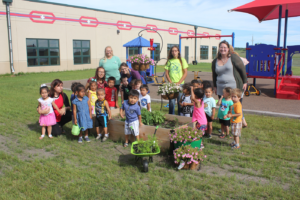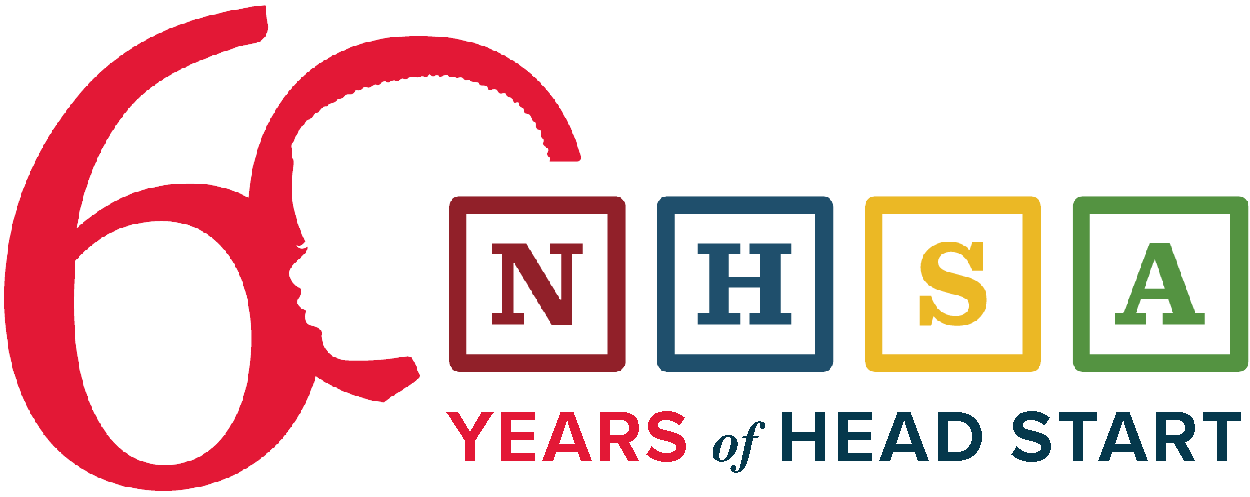Cankdeska Cikana Community College in Fort Totten, North Dakota One of the 2018-2019 Gro More Good gardens grantees, and a classroom gardening success to inspire others who are just getting started. Land Grant Director Heidi Ziegenmeyer shares her top five tips on how to implement a gardening curriculum.
 They say that necessity is the mother of invention. Necessity may have given us the idea for the Cankdeska Cikana Community Garden, but we must also credit partnership as a true parent of this successful project. It all started when the Head Start Director approached me with a grant opportunity. The College was already working on a Community Garden, but this second grant would allow us to implement a children’s garden, bringing gardening and related activities to the children of Head Start. We couldn’t say no to that! It was truly a match made in heaven to partner Head Start with the Land Grant Extension at the College. On the college’s end, the Extension could provide the gardening expertise and a garden manager while the Head Start program offered its wonderful teachers to implement a gardening curriculum with the kids – and boy do the kids love it!
Since we serve a tribal community, Spirit Lake Nation, culture has never been far from our minds. The garden was started with a Community Garden Build Day where kids planted seeds and we had a meal and a blessing. The summer progressed and traditional medicinal plants-white sage and sweetgrass-were planted in a special area of the garden. Two-year-olds came out to water their crops and enjoy the nice weather. The whole year wrapped up with a Fall Harvest event including a veggie scavenger hunt and tasting with names in both Dakota and English languages.
They say that necessity is the mother of invention. Necessity may have given us the idea for the Cankdeska Cikana Community Garden, but we must also credit partnership as a true parent of this successful project. It all started when the Head Start Director approached me with a grant opportunity. The College was already working on a Community Garden, but this second grant would allow us to implement a children’s garden, bringing gardening and related activities to the children of Head Start. We couldn’t say no to that! It was truly a match made in heaven to partner Head Start with the Land Grant Extension at the College. On the college’s end, the Extension could provide the gardening expertise and a garden manager while the Head Start program offered its wonderful teachers to implement a gardening curriculum with the kids – and boy do the kids love it!
Since we serve a tribal community, Spirit Lake Nation, culture has never been far from our minds. The garden was started with a Community Garden Build Day where kids planted seeds and we had a meal and a blessing. The summer progressed and traditional medicinal plants-white sage and sweetgrass-were planted in a special area of the garden. Two-year-olds came out to water their crops and enjoy the nice weather. The whole year wrapped up with a Fall Harvest event including a veggie scavenger hunt and tasting with names in both Dakota and English languages.
Tips and Tricks for Getting Your Gardening Curriculum Started
Through all the good times and learning opportunities the garden has given us, we’ve learned some valuable lessons. Here are some tips that have helped to make our gardening experience so successful.- Get the Kids Involved, Outside and In: The kids really enjoyed getting outside and participating in the garden. You should have heard them “ooh” and “aah” each time a bunch of potatoes were pulled up. And the onions! They had so much fun pulling onions. In the classroom, gardening-inspired activities were brought indoors, too. In one lesson, students were exposed to different types of soils (sand vs. loam for example) in sensory tables. They just loved getting their hands dirty and feeling the soils slip through their fingers. Classrooms also started growing their own vegetables indoors, both from seeds and from cuttings of vegetables you can get at the grocery store! They water them and watch them grow from a close-up perspective. Caring for these plants gave the children a sense of responsibility and helped them make the connection to what was happening in the garden right outside their window.
- Leverage Funds: Everyone has to start somewhere, and if you have an idea, there’s probably a grant somewhere that will fund it. However, grants only go so far or they have restrictions, so look for opportunities to apply for other grants for similar projects. That’s how we ended up with both a Community Garden and a Children’s Garden that support each other. Wherever you can, stretch those dollars and make that money grow!
- Partnerships: Partnerships are another way to save money while also maximizing the services you provide. Find agencies whose missions align with yours in some way and ask them about opportunities to partner. You never know who might be looking for a new project. Besides, partnerships look great on grant applications – hint hint!
- Stay Positive: It can be really hard to tackle big projects with multiple people and organizations involved. Try to stay positive and remember that you can do this. You’ve tackled every problem so far, right? Trust that you can face any difficulties as long as you work together. You might have to change, adjust, learn something new, or do something that might seem uncomfortable. You’ve got this.
- Remember Who You Serve: At the end of the day, put everything in perspective and remember why you do what you do, but also remember to engage the community when you make plans. We need to ask the kids, ask their parents, ask the community what is important to them. In some places, like Spirit Lake, gardening and the relationship with nature is important. What’s important where you are? Find out and do that.
More about the Gro More Good Gardens Grants
Through a multi-year partnership, NHSA and the ScottsMiracle-Gro Foundation are bringing the magic of gardening to Head Start programs each year. The grantees receive support in getting their gardens started, implementing a unique gardening curriculum in the classroom, and bringing those lessons home for children to continue the experience with their families. Learn more and prepare to apply for the next cycle of funding!Related Content
